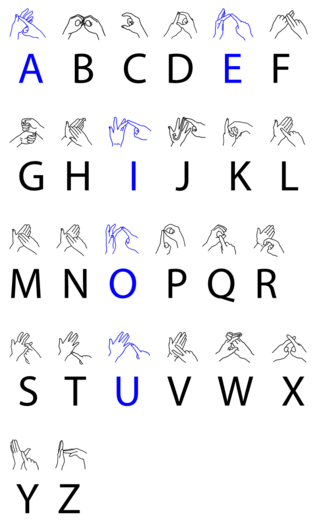
Fingerspelling is the representation of the letters of a writing system, and sometimes numeral systems, using only the hands. These manual alphabets have often been used in deaf education and have subsequently been adopted as a distinct part of a number of sign languages. There are about forty manual alphabets around the world. Historically, manual alphabets have had a number of additional applications—including use as ciphers, as mnemonics and in silent religious settings.

Sign languages are languages that use the visual-manual modality to convey meaning, instead of spoken words. Sign languages are expressed through manual articulation in combination with non-manual markers. Sign languages are full-fledged natural languages with their own grammar and lexicon. Sign languages are not universal and are usually not mutually intelligible, although there are also similarities among different sign languages.

Urdu is an Indo-Aryan language spoken chiefly in South Asia. It is the national language and lingua franca of Pakistan, where it is also an official language alongside English. In India, Urdu is an Eighth Schedule language, the status and cultural heritage of which are recognised by the Constitution of India; and it also has an official status in several Indian states. In Nepal, Urdu is a registered regional dialect and in South Africa it is a protected language in the constitution. It is also spoken as a minority language in Afghanistan and Bangladesh, with no official status.

British Sign Language (BSL) is a sign language used in the United Kingdom and is the first or preferred language among the deaf community in the UK. While private correspondence from William Stokoe hinted at a formal name for the language in 1960, the first usage of the term "British Sign Language" in an academic publication was likely by Aaron Cicourel. Based on the percentage of people who reported 'using British Sign Language at home' on the 2011 Scottish Census, the British Deaf Association estimates there are 151,000 BSL users in the UK, of whom 87,000 are Deaf. By contrast, in the 2011 England and Wales Census 15,000 people living in England and Wales reported themselves using BSL as their main language. People who are not deaf may also use BSL, as hearing relatives of deaf people, sign language interpreters or as a result of other contact with the British Deaf community. The language makes use of space and involves movement of the hands, body, face and head.
Auslan is the sign language used by the majority of the Australian Deaf community. The term Auslan is a portmanteau of "Australian Sign Language", coined by Trevor Johnston in the 1980s, although the language itself is much older. Auslan is related to British Sign Language (BSL) and New Zealand Sign Language (NZSL); the three have descended from the same parent language, and together comprise the BANZSL language family. Auslan has also been influenced by Irish Sign Language (ISL) and more recently has borrowed signs from American Sign Language (ASL).

French Sign Language is the sign language of the deaf in France and French-speaking parts of Switzerland. According to Ethnologue, it has 100,000 native signers.

Marwari is a language within the Rajasthani language family of the Indo-Aryan languages. Marwari and its closely related varieties like Dhundhari, Shekhawati and Mewari form a part of the broader Marwari language family. It is spoken in the Indian state of Rajasthan, as well as the neighbouring states of Gujarat and Haryana, some adjacent areas in eastern parts of Pakistan, and some migrant communities in Nepal. There are two dozen varieties of Marwari. Marwari is also referred to as simply Rajasthani.

Manualism is a method of education of deaf students using sign language within the classroom. Manualism arose in the late 18th century with the advent of free public schools for the deaf in Europe. These teaching methods were brought over to the United States where the first school for the deaf was established in 1817. Today manualism methods are used in conjunction with oralism methods in the majority of American deaf schools.
Manually Coded English (MCE) is an umbrella term referring to a number of invented manual codes intended to visually represent the exact grammar and morphology of spoken English. Different codes of MCE vary in the levels of adherence to spoken English grammar, morphology, and syntax. MCE is typically used in conjunction with direct spoken English.
Manually coded languages (MCLs) are a family of gestural communication methods which include gestural spelling as well as constructed languages which directly interpolate the grammar and syntax of oral languages in a gestural-visual form—that is, signed versions of oral languages. Unlike the sign languages that have evolved naturally in deaf communities, these manual codes are the conscious invention of deaf and hearing educators, and as such lack the distinct spatial structures present in native deaf sign languages. MCLs mostly follow the grammar of the oral language—or, more precisely, of the written form of the oral language that they interpolate. They have been mainly used in deaf education in an effort to "represent English on the hands" and by sign language interpreters in K-12 schools, although they have had some influence on deaf sign languages where their implementation was widespread.
Iranian Sign Language (ISL) is the sign language used by Deaf and hard-of-hearing people in Iran. It is a true sign language, unlike the Baghcheban phonetic hand alphabet, which is a form of cued speech.
Argentine Sign Language is used in Argentina. Deaf people attend separate schools, and use local sign languages out of class. A manual alphabet for spelling Spanish has been developed.
Estonian Sign Language is the national sign language of Estonia.
In the United States, deaf culture was born in Connecticut in 1817 at the American School for the Deaf, when a deaf teacher from France, Laurent Clerc, was recruited by Thomas Gallaudet to help found the new institution. Under the guidance and instruction of Clerc in language and ways of living, deaf American students began to evolve their own strategies for communication and for living, which became the kernel for the development of American Deaf culture.
The Second International Congress on Education of the Deaf was an international conference of deaf educators held in Milan, Italy in 1880. It is commonly known as the "Milan Conference" or "Milan Congress". This Congress was preceded by the First International Congress in Paris in 1878. Joseph Marius Magnat, a Swiss former oralist, received a significant donation to organize the more well-known Second Congress two years hence.
Around seven Tanzanian sign languages were independently developed among deaf students in separate Tanzanian schools for the deaf, starting in 1963. However, the use of several is forbidden by their respective schools. In 1984, a standardized Tanzanian Sign Language was proposed by the Tanzania Association for the Deaf, using common or similar signs where these exist in schools that allowed research. However, it has not been officially implemented, and there remains little influence between the languages. A dictionary has been produced. Lexically, the variety that developed in the oralist deaf school in Tabora is significantly different from the dictionary and is under investigation.
Nepalese Sign Language or Nepali Sign Language (Nepali: नेपाली साङ्केतिक भाषा, romanized: Nēpālī Sāṅkētika Bhāṣā is the main sign language of Nepal. It is a partially standardized language based informally on the variety used in Kathmandu, with some input from varieties from Pokhara and elsewhere. As an indigenous sign language, it is not related to oral Nepali. The Nepali Constitution of 2015 specifically mentions the right to have education in Sign Language for the deaf. Likewise, the newly passed Disability Rights Act of 2072 BS defined language to include "spoken and sign languages and other forms of speechless language." in practice it is recognized by the Ministry of Education and the Ministry of Women, Children and Social Welfare, and is used in all schools for the deaf. In addition, there is legislation underway in Nepal which, in line with the UN Convention on the Rights of Persons with Disabilities which Nepal has ratified, should give Nepalese Sign Language equal status with the oral languages of the country.
In sign language, an initialized sign is one that is produced with a handshape(s) that corresponds to the fingerspelling of its equivalent in the locally dominant oral language, based on the respective manual alphabet representing that oral language's orthography. The handshape(s) of these signs then represent the initial letter of their written equivalent(s). In some cases, this is due to the local oral language having more than one equivalent to a basic sign. For example, in ASL, the signs for "class" and "family" are the same, except that "class" is signed with a 'C' handshape, and "family" with an 'F' handshape. In other cases initialization is required for disambiguation, though the signs are not semantically related. For example, in ASL, "water" it signed with a 'W' handshape touching the mouth, while "dentist" is similar apart from using a 'D' handshape. In other cases initialization is not used for disambiguation; the ASL sign for "elevator", for example, is an 'E' handshape moving up and down along the upright index finger of the other hand.
Ukrainian Sign Language (USL) (Ukrainian: Українська жестова мова (УЖМ), romanized: Ukrayinska zhestova mova (UZhM)) is the sign language of the deaf community of Ukraine. Ukrainian Sign Language belongs to the family of French sign languages. Worldwide awareness of Ukrainian Sign Language rose sharply in 2014 after the release of a Ukrainian film The Tribe, where actors communicated in Ukrainian Sign Language with no spoken dialogue.
The sociolinguistics of sign languages is the application of sociolinguistic principles to the study of sign languages. The study of sociolinguistics in the American Deaf community did not start until the 1960s. Until recently, the study of sign language and sociolinguistics has existed in two separate domains. Nonetheless, now it is clear that many sociolinguistic aspects do not depend on modality and that the combined examination of sociolinguistics and sign language offers countless opportunities to test and understand sociolinguistic theories. The sociolinguistics of sign languages focuses on the study of the relationship between social variables and linguistic variables and their effect on sign languages. The social variables external from language include age, region, social class, ethnicity, and sex. External factors are social by nature and may correlate with the behavior of the linguistic variable. The choices made of internal linguistic variant forms are systematically constrained by a range of factors at both the linguistic and the social levels. The internal variables are linguistic in nature: a sound, a handshape, and a syntactic structure. What makes the sociolinguistics of sign language different from the sociolinguistics of spoken languages is that sign languages have several variables both internal and external to the language that are unique to the Deaf community. Such variables include the audiological status of a signer's parents, age of acquisition, and educational background. There exist perceptions of socioeconomic status and variation of "grassroots" deaf people and middle-class deaf professionals, but this has not been studied in a systematic way. "The sociolinguistic reality of these perceptions has yet to be explored". Many variations in dialects correspond or reflect the values of particular identities of a community.






